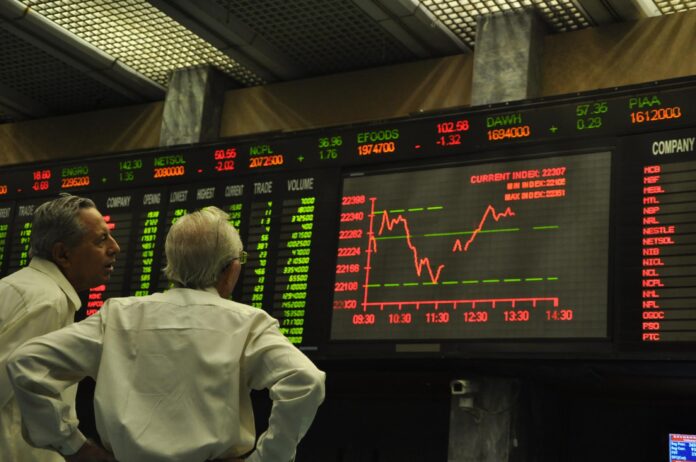Boxing Day Sales came early with the PSX crash. Stocks are now cheaper than they were before. The index flirted with a market halt nearly touching it throughout the trading day. Had the market plunged 5%, we would have seen a market halt, the first of its kind following March 2020.
Stocks on Thursday recorded their worst single-day fall in more than 20 months, with investors stuck in a selling frenzy over economic fallout from ballooning trade deficit and fears of another rate hike. The MPS policy came early this month, earlier than usual because the SBP could anticipate angst in the market.
The last time the PSX witnessed a market halt was when equities around the world plunged in light of COVID 19 due to uncertainty regarding the global economy, liquidity crunches, and loss of productivity for businesses due to lockdowns. So what really triggered this? What went so wrong that the market went into absolute mayhem. “It’s a knee jerk reaction to mainly a couple of factors,” says Fahad Rauf, Head of Research at Ismail Iqbal Securities.
The reasons behind Thursday Turmoil?
We’re going to attribute this to three major reasons, the current account deficit, the debt market yields, and sentiments.
The current account deficit
The Pakistan Bureau of Statistics (PBS) on Thursday released data which showed that the trade deficit widened to $20.6 billion in the first five months of the current fiscal year due to a significant surge in imports that outpaced the increase in exports.
The deficit clocked in at $10.9 billion, or 112%, more than the comparative period of previous fiscal year. In absolute terms, there was an increase of $2.6 billion in exports during FY22. In this fiscal year, exports stand at 47% of the annual target of $26.3 billion. However, the Ministry of Commerce projects that exports will touch $31 billion in the full fiscal year.

In absolute terms, the imports grew $13.5 billion, according to the PBS, despite the SBP introducing a cash margin requirement for more imported goods in addition to steps to curtail consumer finance.
On a monthly basis, November Imports jumped to $7.84 billion in November, which were higher by 83%, or $3.6 billion, over a year ago, according to the PBS. This was the highest-ever import figure, which was $1.5 billion more than the estimate of the Ministry of Commerce, making the external sector projections come into question.
Exports of goods remained at $2.9 billion in November 2021. They clocked in higher by 33%, or $713 million, over the same month of previous year. As a result, the trade deficit widened 134% year-on-year to $5 billion in November 2021. Moreover, it is important to note that the exact import numbers were released later with bits of information making it to twitter through the Finance spokesperson and other sources.
Debt market yields
The government has raised Rs338.4 billion by selling three-month T-bills at 10.78% yield against an offer of Rs423.4 billion. It raised another Rs111 billion by selling six-month T-bills at a yield of 11.5%. Banks had offered Rs201 billion. The government raised Rs55 billion by selling 12-month T-bills at 11.51% against an offer of Rs125 billion.
Before we analyze the yields it’s very important to have context for the market reaction. On November 16, the SBP announced the Monetary Policy Committee meeting would be held 7 days earlier than planned, i.e. November 19 instead of November 26. This came a day after the CRR was increased by 100 bps on Monday or November 15.
On November 18, the SBP held a T bill auction where 6 month t bill bids were rejected at 10.2%. We will discuss that shortly. On November 19, the MPC meeting was held and the policy rate went up by a whopping 150 bps. This development was important enough to warrant a cover story and an interview by the Governor State Bank of Pakistan. On the same day, the SBP announced more MPC meetings than before which also signals the rate hikes may be faster, or may require less drastic jumps like 150bps given the repeated frequency.
On November 30, the PBS released inflation stats where inflation clocked in at a 21 month high, thus signaling that the policy rate is bound to go up in the future too. Inflation stood at 11.5% in November, higher than the market estimates of 10%. In October, inflation clocked in at 9.2%.
On December 1, a T bill auction was held where Rs 110 billion 6 month t bills were accepted at 11.5%. The next day, December 2, the PSX crashed, or as we’d like to call it Chundrigar Catastrophe. This is also the day we got our trade numbers but you’ve already read about that.
So what’s happening on the lending front? The lending rate of commercial banks for offering budgetary support to the government soared on Wednesday when inflation shot up to a 21 month high. Basically there is a sharp increase in the banks’ lending rate for three, six, and twelve month treasury bills as banks anticipate another aggressive policy rate hike. The cut off yields increased by a massive 228 basis points for the three month t bills bringing them to 10.78% compared to 8.5% in the previous auction held on November 17. The next MPC meeting is scheduled for December 14. The market anticipates another rate hike and would rather participate in the auction following the hike.
Pakistan Investment Bonds (PIBs) yields rose to their highest in over two years on Friday. In the run-up to the State Bank of Pakistan’s next monetary policy meeting on December 14, the market expects a 100 basis points increase in the policy rate to 9.75 percent considering inflation, current account deficit, global commodity prices, depletion of foreign currency reserves, etc which will push up the policy rate.

Bond yields are up 52 bps over the past two days. After more than two years the 3-year PIB is hovering around 11.89 percent, while 5-year is at 12 percent and 10-year is at 12.3 percent. Bond yields are up 40-55 bps since the last PIB auction on November 29, while they rose 145 bps since SBP increased the policy rate by 150 bps on November 19.
The six-month Karachi interbank offered rate (KIBOR) also rose, hitting a 21-month high to reach 11.5% on Friday. This is 415 bps from a low of 7.3%.The sudden changes in yields and the KIBOR happened after the T-Bill auction on Wednesday. The spread between KIBOR and policy rate has increased significantly to 275 bps compared with the last three-year average differential of 50 bps. It is important to note that with the IMF program in place, the government will be borrowing more from banks as this is the largest window available for government borrowing.
More importantly, this also puts a lot into question regarding financial prudence. The 6M auction on November 18 was of Rs 111 billion, the same as the amount that was raised on December 1. Rejecting bids on November 18 now means that the government of Pakistan will now be paying 1.2% extra interest on the debt raised. This means they will be paying 11.5% per annum as opposed to 10.2% they could have been paying. To put this in easier numbers, the government will now pay Rs 666 million more interest for 6 months. The fact that the MPC was brought about earlier further makes it absurd that the bids were rejected, especially knowing there is going to be a rate hike (it was so obvious).
Sentiments
Folks down at the PSX aren’t the most rational out there. They tend to panic more than usual. However, considering everything that was going on, it does not come as a surprise. Following the MPC announcement, the Governor State Bank made 5 media appearances including on TV, international media, and through an Op-ed. Not only that, the SBP also issued a clarification note in response to critical op-eds.
While the goal would have been to calm sentiments not necessarily targeting the PSX, the messaging was the opposite. This made a sense of panic within sectors of the economy over the future and what is to come. Moreover, with the inflation numbers being published and then taken off the web, trade stats being released after a lot of speculation, the PSX had a bad day.
While the PSX is not really an accurate indicator of the economy, it is pertinent to note that the PSX investors reacted to the local economic climate as opposed to precious covid related crashes we saw earlier in 2020.
“Stock market is cheap on valuations, but in the short term sentiments can overshadow fundamentals. In the longer term, equities have outperformed other asset classes and could continue to do so in my opinion,” says Rauf.
However, it is also important to note that when the interest rate goes up investors are often seen withdrawing their funds from equities and moving them into safer haves such as government paper and securities or merely investing in banks for solid stable returns. It is likely that the PSX index may not recover as robustly as it would have under a situation of lower interest rates.
What are market halts?
These automatic halts are triggered in order to calm panic-stricken market conditions and present an opportunity for the markets to cool down. A ‘market halt’ is a standard protocol for risk management purposes which is triggered when the KSE-30 Index moves 5 per cent either way and remains there for five consecutive minutes.
It is pertinent to mention that the Pakistan Stock Exchange (PSE) widened the circuit breakers and introduced a market halt from January 20, 2020.
As per the announcement, the exchange applies index-based market halts when the KSE-30 index moves 4pc either way from its opening index value. However, once the circuit breakers reach the level of 7.5pc, market halts are only applicable in case the KSE-30 index moves 5pc either way.
The central idea behind the implementation of market halts is to give investors the time to think about the market conditions without chaos crowding their judgment. This also gives them time to review and reassess the situation, gather information and make informed decisions.
Market halts act as speed bumps and prevent the markets from heading full speed toward a crash. Saad Rafi, head of Sales at Al Habib Capital Markets, commented, “Circuit breakers help PSX from a free fall in panic situations — like 2008 and 2020. These circuit breakers not only limit the daily losses, they also give people time to rethink their investment strategy for the next day or any positive development that comes after market hours will have limited losses on their portfolio.”
According to market participants, while the automatic halts are an attempt to inject stability in the market, they may not be as effective at calming panic-induced selling. As levels that induce market halts approach, some investors increase their panic-induced selling due to the fear of not being able to sell. This may push them to dump their stocks at any price they can get.
This is known as the magnet effect. The magnet effect theory claims, “As the market approaches levels near the circuit breaker threshold, investors will increase the volume by which they are unloading their shares. This is driven off the fear of being stuck with their positions given the market halt is put in place.”
A disadvantage of the market halts is the impact they have on liquidity. They reduce liquidity and have a strong impact on price discovery. Price discovery is the quantification of the willingness and investor has to sell or buy a number of shares. This may result in a larger bid-ask spread, which will further slow down the price discovery. Sami Tariq, Head of Research and Business Development at Arif Habib limited said, “The circuit breakers in the market should be placed at a reasonable level. 5pc is too little.”


























A good article with a comprehensive economical outlook.